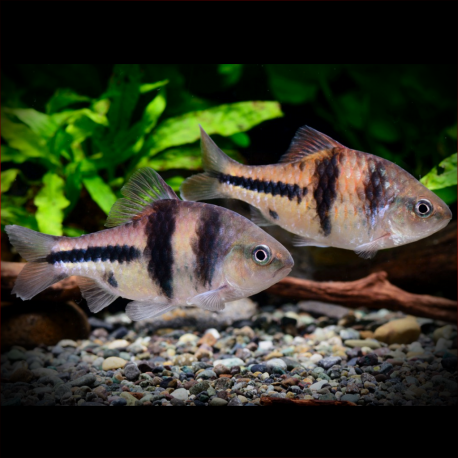More info
Datasheet
| Minimum Tank Size | 240 litres / 63.40 US gallons |
| Maximum Size | 12.0cm / 4.72inches |
| Temperature | 20°C / 68.00°F - 28°C / 82.40°F |
| Hardness | 1.01dgH / 18ppm - 12.05dgH / 215ppm |
| pH | 5.0-7.5 |
General Description
The False Spanner Barb (Barbodes kuchingensis) is a species rarely encountered in the aquarium trade, sometimes confused with other similar members like B. everetti and various populations of B. lateristriga. Despite its infrequent availability, it can be distinguished by its row of dark spots along the lateral line and a short streak from the operculum. Previously classified in the genus Puntius, taxonomic revisions have placed it in Barbodes. This species can reach sizes up to 12.0 cm and presents typical cyprinid features.
Aquarium Setup
Creating a tank environment akin to a flowing river or stream is advisable for housing the False Spanner Barb. The setup should include a mix of water-worn rocks, sand, gravel, and small boulders. Enhance the tank with driftwood, roots, or branches, and consider attaching hardy aquatic plants like Microsorum and Anubias species to the decor. It is crucial to maintain pristine water conditions, providing ample dissolved oxygen and moderate water movement.
Behaviour
In an aquarium setting, False Spanner Barbs thrive when kept in groups of 8-10 individuals, displaying a gregarious nature. Living in cohesion helps reduce skittish behaviors and promotes a more natural appearance within the tank. When housed with peaceful, similarly sized species, this Barb tends to exhibit minimal aggressive tendencies as it focuses on maintaining hierarchy within group dynamics.
Feeding and Diet
In the wild, False Spanner Barbs are presumed to be foragers, consuming a variety of diatoms, algae, small insects, worms, and zooplankton. In captivity, they readily accept small live and frozen foods such as bloodworms, Daphnia, and Artemia. Supplementing their diet with high-quality dried flakes and granules is recommended, ensuring some options contain plant-based components for a balanced nutritional intake.
Reproduction & Dimorphism
Details regarding the reproduction of the False Spanner Barb remain unrecorded. Adult males typically exhibit more intense coloration and develop noticeable tubercules on their heads during spawning periods. Conversely, adult females tend to be larger, heavier-bodied, and display subdued coloration in comparison to males.
Habitat and Distribution
This species is native to western Borneo, with its range extending into the Indonesian province of West Kalimantan. False Spanner Barbs are predominantly found in shallow forest streams, often with substrates of rocks, sand, or gravel. They have also been documented in ancient peat swamps and blackwater streams with minimal mineral content and low pH levels. Within their habitats, the Barb coexists with various species such as Rasbora sarawakensis and Betta taeniata.

